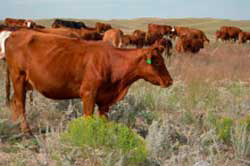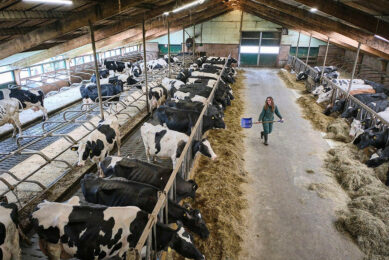Effect of nutrition on pregnancy in heifers and young cows

How much does nutrition impact the reproductive rates of cattle? According to Dr Rick Funston, UNL Beef Reproductive Specialist, “The nutritional status of animals is difficult to measure, and this complicates interpretation of nutrition x reproduction interactions. An animal’s nutritional status is usually assessed on changes in its live weight and body condition. However, these are long-term changes while many of the events of reproduction, e.g. ovulation, fertilisation, and placentation, take only a short time.” Research has shown an increase in pregnancy rates with a “flushing effect.” Cattle bred on an increasing plane of nutrition have shown higher pregnancy rates than cattle bred on a declining plane of nutrition.
Can producers use this “flushing effect” to their advantage?
First, think about when your cows are breeding. For a March calving herd in the Sandhills, high quality forage is available in June when cows are bred. However, a May calving herd would be grazing August grass, which is maturing and protein levels will likely be declining.
“During a normal year, I would recommend supplementing the “high risk” animals but this year the entire herd may need supplementation,” says Funston about the later calving herd.
However, Funston notes, this year’s early spring calving herds may need to consider the impact continued drought conditions will have on forage . First, if pastures remain dry, the forage availability and quality could be poor, even in June. Second, if abundant rains do come, the forage may be too high in protein and lacking energy, causing lower pregnancy rates. “Just as we take precautions while grazing irrigated grass while breeding cows, a lush pasture with no old grass may cause a similar effect.”
Supplementation during the breeding season
Research at the Gudmundsen Sandhills Laboratory (GSL) has observed a lower pregnancy rate in the May calving herd, especially the younger 1st and 2nd calvers and heifer calves. The older cows (4 and older) appear to breed similar to the earlier spring calving herd. “These were two years of “normal” to above normal precipitation and we still had issues with these “high risk” animals breeding without supplementation,” said Funston.
Last year, they tried “flushing” the younger females in the May herd. The heifer calves and first calf heifers received a protein supplement 10 days prior to the breeding season (bull turn-out or AI) and during the breeding season. Both groups were synchronised and bred for 45 days, and received supplement for 55 days total.
At GSL, the first year of results is favourable for the May calving herd. The heifer calves (receiving 1 lb. of 30% protein cake) bred 82% versus the non-supplemented heifers (59% pregnancy rate). The first calf heifers (receiving 2 lbs. of a 30% protein cake) bred 87% versus the non-supplemented animals who only bred 53%.
Before you turn out bulls this year, consider the quality and quantity of your forage during the breeding season. Supplementation during the breeding season may be an option to consider this year. A flushing effect can also be accomplished in a drylot situation.
Updated information on synchronisation systems, a synchronisation planner, and Applied Reproductive Strategies in Beef Cattle proceedings can be found at http://beefrepro.info.
Source: Bethany Johnston, UNL Extension Educator, Panhandle Research & Extension Center, University of Nebraska–Lincoln











